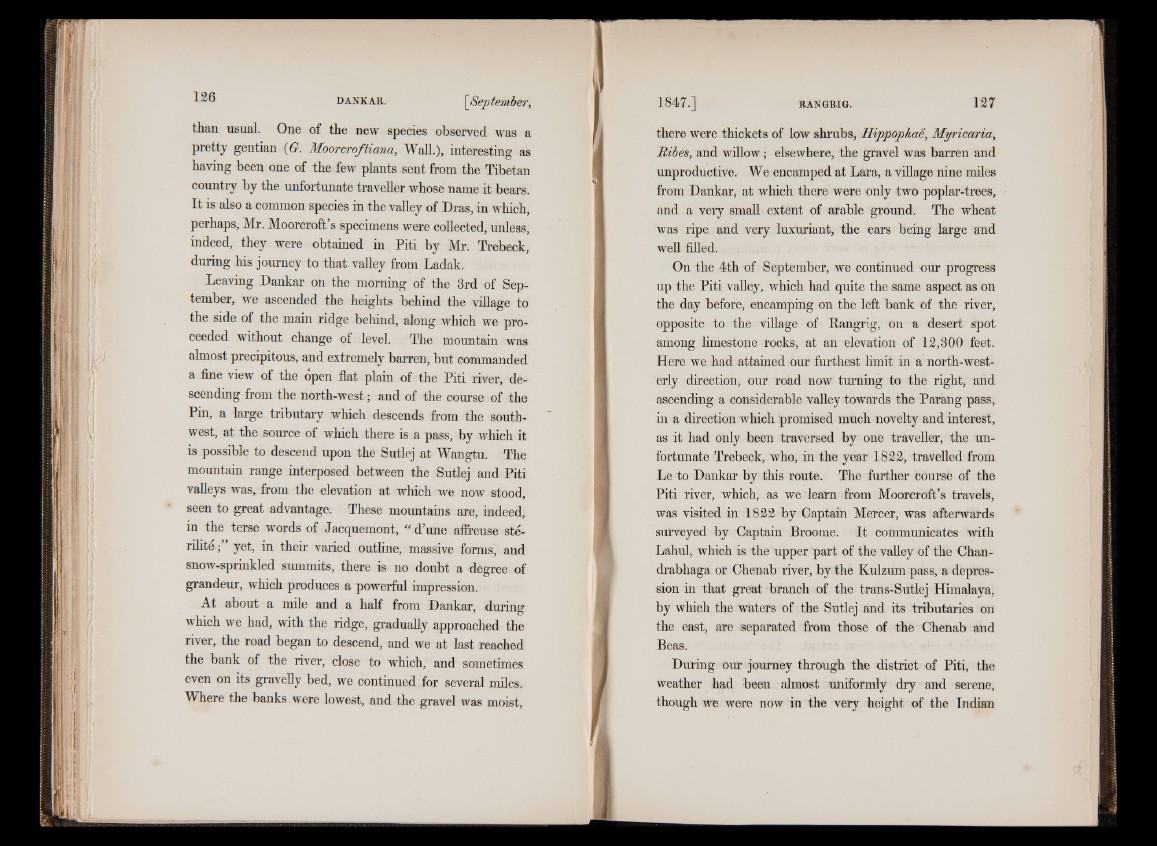
than usual. One of the new species observed was a
pretty gentian (G. Moorcroftiana, Wall.), interesting as
having been one of the few plants sent from the Tibetan
country by the unfortunate traveller whose name it bears.
It is also a common species in the valley of Dras, in which,
perhaps, Mr. Moorcroft’s specimens were collected, unless,
indeed, they were obtained in Piti by Mr. Trebeck,
during his journey to that valley from Ladak.
Leaving Dankar on the morning of the 3rd of September,
we ascended the heights behind the village to
the side of the main ridge behind, along which we proceeded
without change of level. The mountain was
almost precipitous, and extremely barren, but commanded
a fine view of the open flat plain of the Piti river, descending
from the north-west; and of the course of the
Pin, a large tributary which descends from the southwest,
at the source of which there is a pass, by which it
is possible to descend upon the Sutlej at Wangtu. The
mountain range interposed between the Sutlej and Piti
valleys was, from the elevation at which we now stood,
seen to great advantage. These mountains are, indeed,
in the terse words of Jacquemont, “ d’une affreuse ste-
rilite; yet, in their varied outline, massive forms, and
snow-sprinkled summits, there is no doubt a degree of
grandeur, which produces a powerful impression.
At about a mile and a half from Dankar, during
which we had, with the ridge, gradually approached the
river, the road began to descend, and we at last reached
the bank of the river, close to which, and sometimes
even on its gravelly bed, we continued for several miles.
Where the banks were lowest, and the gravel was moist,
there were thickets of low shrubs, Hippophae, Myricaria,
Hides, and willow; elsewhere, the gravel was barren and
unproductive. We encamped at Lara, a village nine miles
from Dankar, at which there were only two poplar-trees,
and a very small extent of arable ground. The wheat
was ripe and very luxuriant, the ears being large and
well filled.
On the 4th of September, we continued our progress
up the Piti valley, which had quite the same aspect as on
the day before, encamping on the left bank of the river,
opposite to the village of Rangrig, on a desert spot
among limestone rocks, at an elevation of 12,300 feet.
Here we had attained our furthest limit in a north-westerly
direction, our road now turning to the right, and
ascending a considerable valley towards the Parang pass,
in a direction which promised much novelty and interest,
as it had only been traversed by one traveller, the unfortunate
Trebeck, who, in the year 1822, travelled from
Le to Dankar by this route. The further course of the
Piti river, which, as we learn from Moorcroft’s travels,
was visited in 1822 by Captain Mercer, was afterwards
surveyed by Captain Broome. It communicates with
Lahul, which is the upper part of the valley of the Chan-
drabhaga or Chenab river, by the Kulzum pass, a depression
in that great branch of the trans-Sutlej Himalaya,
by which the waters of the Sutlej and its tributaries on
the east, are separated from those of the Chenab and
Beas.
During our journey through the district of Piti, the
weather had been almost uniformly dry and serene,
though we were now in the very height of the Indian